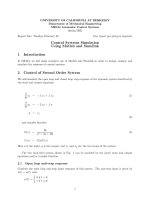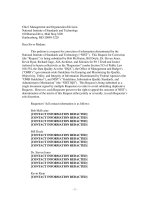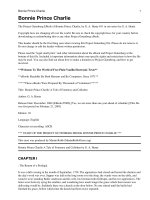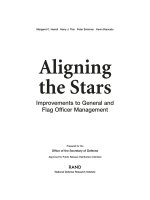Computer Simulation of General and Flag Officer Management - Model Description and Results ppt
Bạn đang xem bản rút gọn của tài liệu. Xem và tải ngay bản đầy đủ của tài liệu tại đây (689.97 KB, 57 trang )
This document and trademark(s) contained herein are protected by law as indicated in a notice appearing later in
this work. This electronic representation of RAND intellectual property is provided for non-commercial use only.
Unauthorized posting of RAND PDFs to a non-RAND Web site is prohibited. RAND PDFs are protected under
copyright law. Permission is required from RAND to reproduce, or reuse in another form, any of our research
documents for commercial use. For information on reprint and linking permissions, please see RAND Permissions.
Limited Electronic Distribution Rights
This PDF document was made available from www.rand.org as a public
service of the RAND Corporation.
6
Jump down to document
THE ARTS
CHILD POLICY
CIVIL JUSTICE
EDUCATION
ENERGY AND ENVIRONMENT
HEALTH AND HEALTH CARE
INTERNATIONAL AFFAIRS
NATIONAL SECURITY
POPULATION AND AGING
PUBLIC SAFETY
SCIENCE AND TECHNOLOGY
SUBSTANCE ABUSE
TERRORISM AND
HOMELAND SECURITY
TRANSPORTATION AND
INFRASTRUCTURE
WORKFORCE AND WORKPLACE
The RAND Corporation is a nonprofit research
organization providing objective analysis and effective
solutions that address the challenges facing the public
and private sectors around the world.
Visit RAND at www.rand.org
Explore the RAND National Defense Research Institute
View document details
For More Information
Purchase this document
Browse Books & Publications
Make a charitable contribution
Support RAND
This product is part of the RAND Corporation technical report series. Reports may
include research findings on a specific topic that is limited in scope; present discus-
sions of the methodology employed in research; provide literature reviews, survey
instruments, modeling exercises, guidelines for practitioners and research profes-
sionals, and supporting documentation; or deliver preliminary findings. All RAND
reports undergo rigorous peer review to ensure that they meet high standards for re-
search quality and objectivity.
Computer Simulation
of General and Flag
Officer Management
Model Description and Results
Peter Schirmer
Sponsored by the Office of the Secretary of Defense
Approved for public release; distribution unlimited
NATIONAL DEFENSE RESEARCH INSTITUTE
The RAND Corporation is a nonprofit research organization providing objective analysis
and effective solutions that address the challenges facing the public and private sectors
around the world. RAND’s publications do not necessarily reflect the opinions of its
research clients and sponsors.
R
®
is a registered trademark.
© Copyright 2009 RAND Corporation
Permission is given to duplicate this document for personal use only, as long as it is unaltered
and complete. Copies may not be duplicated for commercial purposes. Unauthorized
posting of RAND documents to a non-RAND Web site is prohibited. RAND
documents are protected under copyright law. For information on reprint and linking
permissions, please visit the RAND permissions page (
permissions.html).
Published 2009 by the RAND Corporation
1776 Main Street, P.O. Box 2138, Santa Monica, CA 90407-2138
1200 South Hayes Street, Arlington, VA 22202-5050
4570 Fifth Avenue, Suite 600, Pittsburgh, PA 15213-2665
RAND URL:
To order RAND documents or to obtain additional information, contact
Distribution Services: Telephone: (310) 451-7002;
Fax: (310) 451-6915; Email:
Library of Congress Cataloging-in-Publication Data is available for this publication.
978-0-8330-4737-3
The research described in this report was prepared for the Office of the Secretary of Defense
(OSD). The research was conducted in the RAND National Defense Research Institute, a
federally funded research and development center sponsored by the OSD, the Joint Staff,
the Unified Combatant Commands, the Department of the Navy, the Marine Corps, the
defense agencies, and the defense Intelligence Community under Contract W74V8H-
06-C-0002.
iii
Preface
e RAND Corporation analyzes military manpower and personnel issues for the Depart-
ment of Defense using a variety of methods, including computer modeling. e models pro-
vide insights regarding the promotion, assignment, retention, and development of military
officers; they also provide insights into systemwide issues, such as end-strength management
and bench strength for key positions.
In recent years, the RAND National Defense Research Institute has developed a sim-
ulation model that is capable of managing hundreds or thousands of officers individually
according to complex laws, policies, and practices. e model can address very detailed ques-
tions that are not easily answered using spreadsheet models, stock-and-flow models, or linear-
programming models. e simulation model has been applied to research sponsored by the
Office of the Secretary of Defense, the Army, the Navy, and the Air Force.
is technical report describes the design of a version of the simulation model that has
been adapted specifically to address general and flag officer management subject to provisions
of the Duncan Hunter National Defense Authorization Act for Fiscal Year 2009. e report
also provides results requested by the Office of the Secretary of Defense, which has sponsored
most of the work using different versions of the simulation model.
is research was sponsored by the Office of the Secretary of Defense and conducted
within the Forces and Resources Policy Center of the RAND National Defense Research
Institute, a federally funded research and development center sponsored by the Office of the
Secretary of Defense, the Joint Staff, the Unified Combatant Commands, the Department of
the Navy, the Marine Corps, the defense agencies, and the defense intelligence community.
e principal investigators are Peter Schirmer and Margaret Harrell. Comments are welcome
and may be addressed to or to
For more information on RAND’s Forces and Resources Policy Center, contact the
Director, James Hosek, by email at ; by phone at 310-393-0411, exten-
sion 7183; or by mail at the RAND Corporation, 1776 Main Street, Santa Monica, CA 90407-
2138. More information about RAND is available at www.rand.org.
v
Contents
Preface iii
Figures
vii
Tables
ix
Summary
xi
Acknowledgments
xiii
Acronyms and Abbreviations
xv
CHAPTER ONE
Background 1
CHAPTER TWO
Model Description 3
Entity Characteristics
3
Model Inputs
6
Model Procedures
7
Model Initialization
7
O-6 “Accessions”
9
Officer Information Updates
9
Retirement Dates
9
Assignment Availability
10
Job-Score Calculation
11
Job Assignments
11
Involuntary Retirements for Lack of Assignment
12
Promotion Numbers and Timing
12
Assignment and Vacancy Forecasts
14
RC Officers on Active Duty
15
Caveats and Concerns
15
CHAPTER THREE
Model Results 17
Why Do End-Strength Violations Occur?
18
Scenarios and Results
18
CHAPTER FOUR
Conclusions 27
APPENDIX
Model Results for Scenarios 2 and 3 29
vii
Figures
2.1. Probability of Retiring, by Time in Grade 10
3.1. Detailed Army Inventory, Scenario 1
21
3.2. Aggregated Army Inventory, Scenario 1
21
3.3. Detailed Air Force Inventory, Scenario 1
22
3.4. Aggregated Air Force Inventory, Scenario 1
22
3.5. Detailed Navy Inventory, Scenario 1
23
3.6. Aggregated Navy Inventory, Scenario 1
23
3.7. Detailed Marine Corps Inventory, Scenario 1
24
3.8. Aggregated Marine Corps Inventory, Scenario 1
24
A.1. Detailed Army Inventory, Scenario 2
31
A.2. Aggregated Army Inventory, Scenario 2
31
A.3. Detailed Air Force Inventory, Scenario 2
32
A.4. Aggregated Air Force Inventory, Scenario 2
32
A.5. Detailed Navy Inventory, Scenario 2
33
A.6. Aggregated Navy Inventory, Scenario 2
33
A.7. Detailed Marine Corps Inventory, Scenario 2
34
A.8. Aggregated Marine Corps Inventory, Scenario 2
34
A.9. Detailed Army Inventory, Scenario 3
36
A.10. Aggregated Army Inventory, Scenario 3
36
A.11. Detailed Air Force Inventory, Scenario 3
37
A.12. Aggregated Air Force Inventory, Scenario 3
37
A.13. Detailed Navy Inventory, Scenario 3
38
A.14. Aggregated Navy Inventory, Scenario 3
38
A.15. Detailed Marine Corps Inventory, Scenario 3
39
A.16. Aggregated Marine Corps Inventory, Scenario 3
39
ix
Tables
2.1. Military Officer Characteristics in the Model 4
2.2. Service Community Characteristics in the Model
4
2.3. Position Characteristics in the Model
5
2.4. Portion of Time in Grade/Time in Service Input Matrix for Seeding Model
with Officers
8
2.5. Portion of Time in Grade/Time in Service Input Matrix Transformed to Show
Whole Numbers of Officers
8
2.6. Active Duty Army O-8 Inventory in an Illustrative Modeling Period
13
2.7. Active Duty Army O-7s (Promotable) in an Illustrative Modeling Period
13
3.1. Active Component End-Strength Analysis for Scenario 1
20
3.2. Reserve Component End-Strength Analysis and Officers in External Positions
for Scenario 1
20
3.3. Active Component End-Strength Analysis for Scenario 1 When Services Do
and Do Not Use eir Entire Joint Pool Credit
25
A.1. Active Component End-Strength Analysis for Scenario 2
30
A.2. Reserve Component End-Strength Analysis and Officers in External Positions
for Scenario 2
30
A.3. Active Component End-Strength Analysis for Scenario 3
35
A.4. Reserve Component End-Strength Analysis and Officers in External Positions
for Scenario 3
35
xi
Summary
e Duncan Hunter National Defense Authorization Act for Fiscal Year 2009 introduced
the joint pool rubric, which provides for the designation of up to 324 general and flag officer
(GFO) positions by the Secretary of Defense. Once designated, the services will be allocated
a number of these joint officer requirements as their fair share. ese positions will not be
counted against service GFO grade- and end-strength ceilings. e revised strength account-
ing rules were designed to increase competition for joint positions and to encourage greater
use of reserve component (RC) GFOs in joint positions, but they will add to the complexity
of managing active component (AC) and RC end and grade strengths. e RAND National
Defense Research Institute (NDRI) was asked to apply its computer simulation models to
assess the complexity and feasibility of managing the new grade- and end-strength accounting
rules.
e modeling results presented in this report support the conclusion that GFO end-
strength management is a tractable challenge. ere is no single number or result that leads
to this conclusion; it is based on an examination of the frequency, magnitude, and duration
of end-strength violations. e simulation model schedules assignments, holds positions open
when needed, forecasts retirements, forecasts promotions, and generally operates under a fairly
sophisticated set of business rules and model procedures similar to real-world processes. With
these processes, the model manages end strength, grade pyramids, and limitations on officers
serving in external positions. End-strength violations do occur, but they appear to fall within
the admittedly amorphous standard of “acceptable.” e active and reserve components will
have to work closely with one another to manage end strength, and they will have to work
closely with the Joint Staff Office of General/Flag Officer Matters as well.
xiii
Acknowledgments
e author is indebted to the individuals from the service offices that manage general and
flag officers: Lieutenant Colonels William Redman and Arthur Stovall, United States Marine
Corps; Commander David Dillensnyder, United States Navy; Colonel omas Seamands,
United States Army, and Bill Atkinson, Army General Officer Management Office; Colonel
Tammy Smith, United States Army Reserve; Colonel William Stoppel, Army National Guard,
and John Ellington, National Guard Bureau; Master Sergeant David Clark, United States
Air Force; and Colonel Stephanie Gass and Lieutenant Colonel Heather Capella, Air Force
Reserve. e staff of the Deputy Under Secretary of Defense for Military Personnel Policy,
especially Lernes Hebert, provided critical support and assistance. Special thanks go to RAND
colleagues Meg Harrell, who was co-leader of this project; Ian Cook, who did some coding of
the model; Michael Tseng, who worked on an earlier version of the model; Jessica Hart, who
assisted with GFO databases; and Lawrence Hanser and Louis Miller, who provided excellent
reviews of the document.









